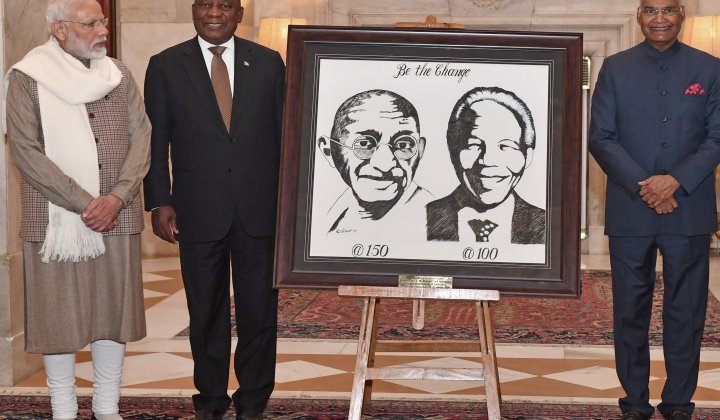Starting an innovation discussion with a nod to leadership buy-in may seem in contrast to the maverick idea we have about breeding innovation in an organisation, but it’s the first and most important building block, says Tony Christodoulou, Chief Information Officer for the EMEA region at American Tower Corporation and a member of GIBS adjunct faculty. “Innovation starts with executive support. If the senior leadership don’t see the need to change or don’t see any reason to innovate, as much as you might have bottom-up innovation, it won’t be sustainable enough to make a bottom-line impact.”
Leaders can, however, get the innovation ball rolling by asking some hard questions about self-disruption and ways in which to cannibalise their existing revenue, says Christodoulou. “Either you are going to be the disruptor, or be disrupted,” says Christodoulou. “So if you have a mindset that asks what a competitor would do to disrupt your business, then that’s a good starting point.”
Of course, this is easier said than done, says global strategist and GIBS faculty, Abdullah Verachia. “Organisations are grappling with the issue of relevance, a much more competitive landscape, and how to address an archaic system built on a traditional way of doing business.” So rather than pause to interrogate how they view innovation and if they regard it as something removed from the organisation or ingrained in the culture, they are rushing to “slap make-up on their legacy systems”.
This approach certainly doesn’t help traditional businesses compete with younger companies unencumbered by legacy systems and cultures, whose leaders have embedded an entrepreneurial flair into the organisations, says Verachia.
While it’s not impossible for companies with a more traditional DNA to create this sort of entrepreneurial culture, it takes a concerted effort and buy-in from across the group, says Verachia, pointing to FNB’s current CEO Jacques Celliers, who is driving innovative ways of working, including the introduction of flexible workspaces, favouring mobile phones above landlines and reducing the bank’s real estate holding. “He doesn’t have an office and he ‘hot desks’ – so he sits anywhere,” says Verachia. “I think he faced massive resistance, but he set the tone.”
Critical processes
GIBS lecturer Dr. Jeff Yu-Jen Chen points out that leaders embarking on an innovation drive can’t do it alone, they need to inspire the rest of the business to change. This means communicating a vision but also interrogating if internal structures, infrastructure, process and culture can handle a radical shift. He asks: “If you want staff to work from home, how do your managers cope if they don’t see their people? Managers need new mindsets to adapt to this new normal. How organisations manage their own unique transformation process, while encouraging full support from all of their employees, becomes the most important question for C-suite officers.”
Chen adds: “We speak about the right kind of leadership for innovation. But all levels of employees, including leaders, must also examine what the right kind of followership is in order to ensure the corporate innovation effort is a success.”
Either you are going to be the disruptor, or be disrupted.
Ultimately managers need to engage with staff about ideas, and work to encourage a culture of collaboration and idea sharing. The moment a manager summarily shoots down an idea or professes to be too busy to listen, then you risk derailing the entire process, says Christodoulou.
“Most ideas are not a eureka moment. A lot of innovation is a process where people get together and come up with what author Steven Johnson calls the ‘hunch effect’,” notes Christodoulou. “This concept says the more people interconnect and the more you create an environment for collaboration, then these multiple hunches become an idea. So how do you create circumstances for collaboration for the natural hunch effect to take place? If it’s a workshop or a strategy session or an event, how do we push people to collaborate on their ideas?”
People-centric thinking
While systems are critical, an organisation’s people must always be at the forefront of its innovation efforts, says Christodoulou. Increasingly this means speaking to a new generation of Gen Z (born mid-1990s to early 2000s) and Millennial (born after 1980 to mid-1990s) workers for whom flexibility, purpose and change are paramount. “Any company that can’t speak to this new generation will find themselves in trouble,” says Christodoulou, himself a Millennial. “You have to be productivity focused, allow for flexibility and make playtime for your team.”
Most Gen Zs and Millennials are diametrically opposed to the linear, traditional view of old-style organisations, agrees Verachia, and as such, they represent the biggest challenge to any organisation. But if you can get these employees on board then you can “start leveraging the collective expertise within an organisation, be it demographically, through gender and culture”, he says.
What does the customer actually want?
Once you have the right mix of innovative individuals – with the requisite curiosity, empathy, imagination, irreverence, collaborative spirit and risk-taking appetite – you need to turn to normalising failure. “Start by looking at effectuation theory by Professor Saras Sarasvathy,” recommends Chen. “This talks to the concept of affordable loss, where an organisation knows what it can afford to lose, so there is minimal risk and minimal negative impact if a project fails. This frees you up to experiment as hard as possible.”
Who are you innovating for?
Fundamentally, of course, innovation needs to speak directly to customer needs. “If we are talking about innovating for our clients, how can we possibly expect to get this right if we are sitting in a darkened room, pondering innovation but disconnected from the very clients we hope to serve?” asks Verachia.
Christodoulou agrees: “Sometimes we are too inwardly focused. We are so blinded by our own internal constraints of operations that we forget about the customer. What does the customer actually want?”
And yet, says Verachia, we see most telcos, banks and retailers creating products and services without even talking to young people, their future customers. Could these old-school organisations ever hope to wiggle out of the hard work required to turn around traditional cultures? Will they ever have the luxury of just placing an order for instantaneous innovation?
Verachia offers a resolute: “Never.”
If you have a legacy company you need to break everything internally, he stresses. “There is always pain, because you are trying to change a system which is supposedly working, but you are future proofing the organisation.” However, you can only achieve an innovation culture when you get support at the right level, says Verachia.
Chen also doubts the likelihood of rapid-fire innovation, adding: “Certainly you should strive for a level where you are highly responsive to external change. Then you could ‘order in’ innovation by buying or partnering with highly innovative external parties, or ‘pep up’ innovation in a company with the right DNA and the right people on board. Some companies, such as Lego and Discovery, have managed to come up with highly innovative core principles that will probably last for a very long period of time. Many of their innovations are as the result of embracing external change which leverages their core principles to create new values.”
But, warns Verachia: “Getting a chief innovation champion dancing around and having an innovation hackathon, all of that stuff is just lipstick. And lipstick fades quickly.”
Types of innovation
Innovation comes in different forms and fulfils difference purposes. It is usually neatly broken up into three types: Transformational innovation (the radical, disruptor type we think of when we talk about driverless cars); incremental innovation (which focuses on doing what you do, but better. Much like Apple and the iPhone); and adjacent innovation (improving existing products and markets. Think Amazon).
Within these broad categories, innovation at a company level could span the likes of:
· Product innovation – improving an existing service or product and its ease of use.
· Process innovation – improving production or delivery methods.
· Marketing innovation – developing new marketing and packaging methods, and promotion and pricing.
· Organisational innovation – creating new business practices and ways in which the organisation is run.
· Business model innovation – finding new ways in which to capture value.
While radical innovation is the rock star of the three innovation types, Tony Christodoulou says: “Everyone thinks innovation means you have to come up with the next lightbulb product. Incremental innovation is just as effective as radical innovation because what drives innovation in the first instance is an appetite from the leadership of the organisation to be open to the idea of investing time and money outside the existing product range for the future.”
A less ‘sexy’ model is the sort rolled out by Chinese manufacturing companies and even by the likes of Naspers, whose CEO, Koos Bekker, has created a culture that is practiced at spotting opportunities, and then copying others efficiently and quickly. Everything under the sun is a copy, says Dr. Jeff Yu-Jen Chen, who points to the latest book by IMD Business School professor Howard Yu – Leap: How to Thrive in a World Where Everything Can Be Copied. “Innovation often comes from combining many other smart ideas strategically and executing the combination timely and effectively,” explains Chen. “It is very important for all organisations to set the goals and boundary of innovation very firmly but empower their people to find the right combinations of ingredients to foster innovation. Disruptive or transformative innovation often comes from borrowing many existing ideas from other areas, but combining them effectively.”
Innovation dos and don’ts
Many South African corporates lack the agility of their younger, more nimble counterparts, so they try to compensate by falling back on the following innovation ‘Band-Aids’, explains Abdullah Verachia:
· Rolling out internal innovation challenges – “Yes, these challenges play a role but they in no way create an entirely innovative culture.”
· Encouraging boundary spanning – allowing employees to work outside their traditional job title and qualification confines.
· Hiring an innovation team – “We’ve seen abject failure on that front, because innovation needs to be in the blood.”
Instead of slapping on one of these Band-Aids, Verachia suggests companies begin by relentlessly asking three important questions across the business and within individual teams. He cites the work of leading futurist Gerd Leonhard:
· Can I do the same things better? “You should be spending 70% of your time asking this question, just to change the corporate mindset.”
· Can I do new things? New things don’t always mean new products and services, but also internal processes. This should take up 20% of your time.
· Can we do new things in a way that make the old ways obsolete? “This is where disruptive innovation comes in,” explains Verachia. Devote 10% of your time to this questioning.
Verachia says most companies are focused on the 10%, “but I think we should focus on the 70% and 20% – on doing things better and doing new things – and this sparks an ability to think differently”.




